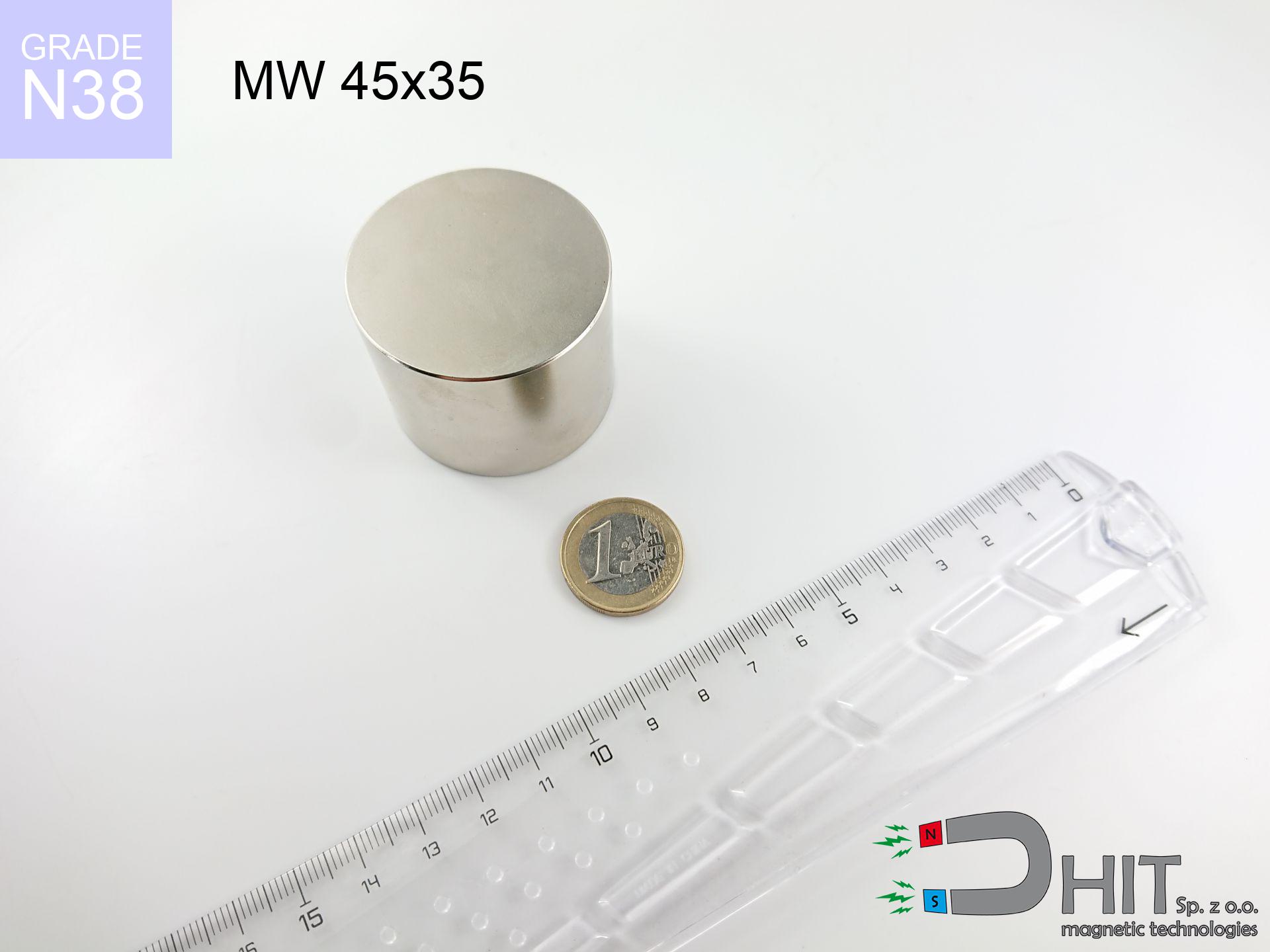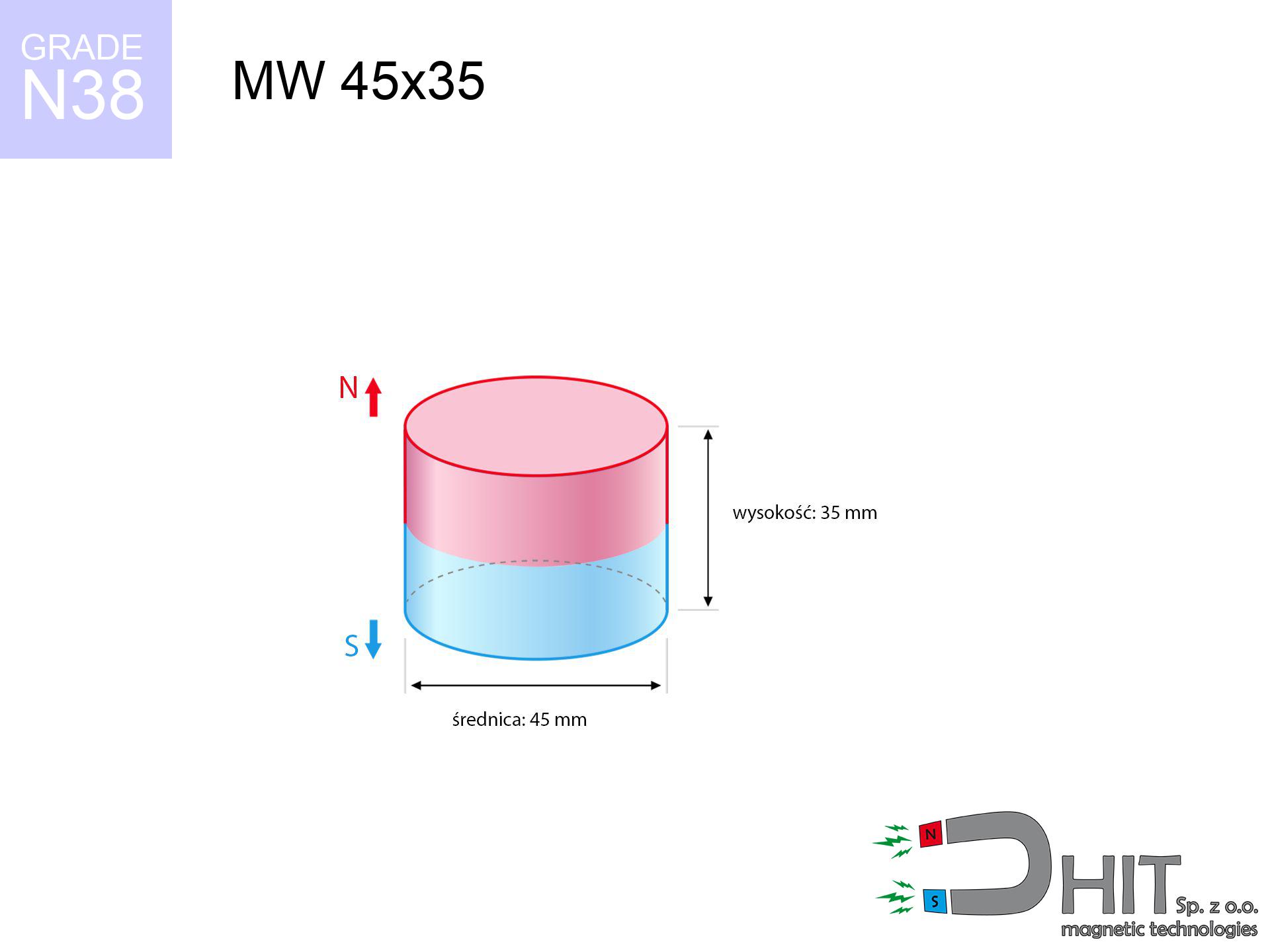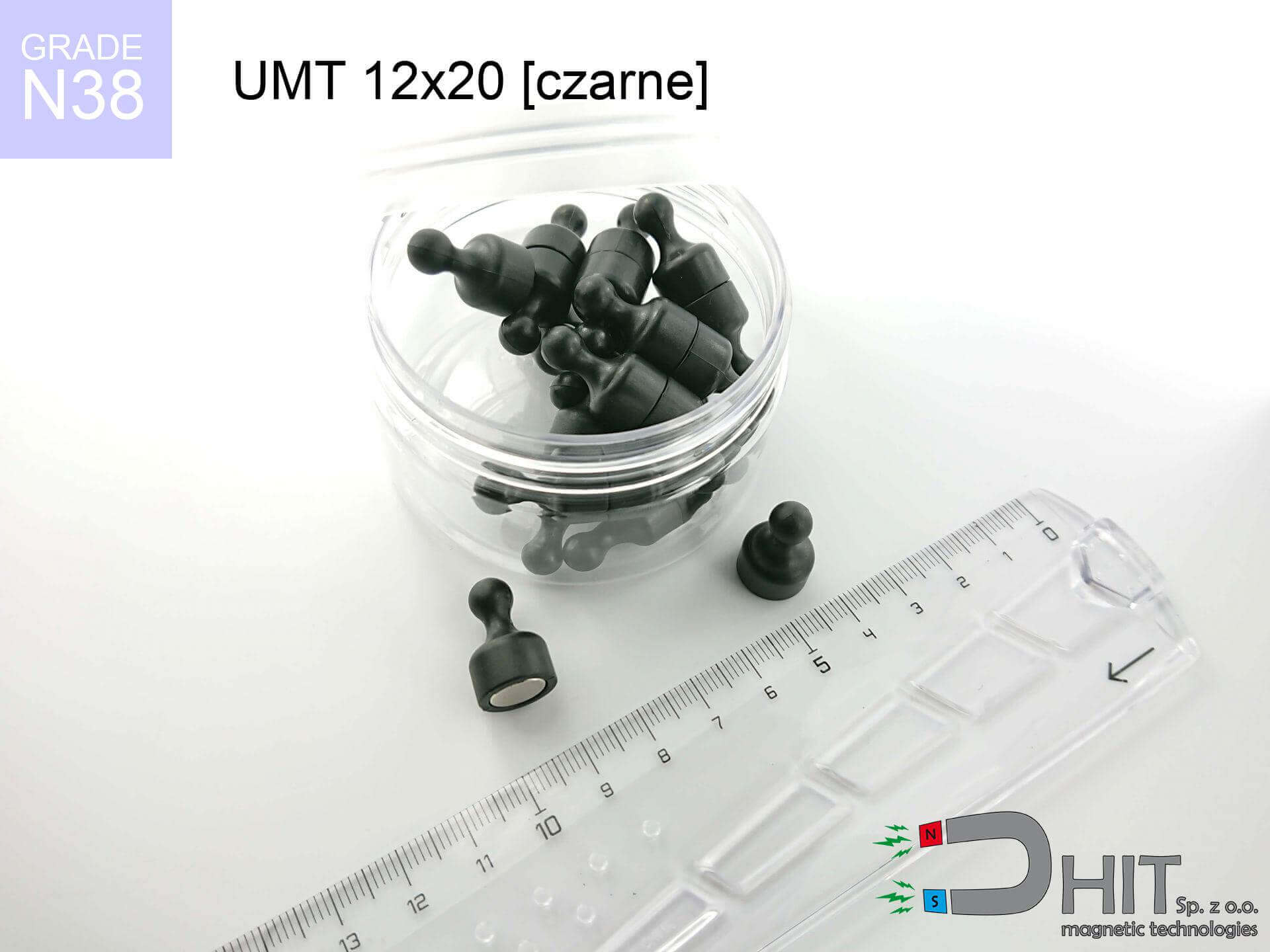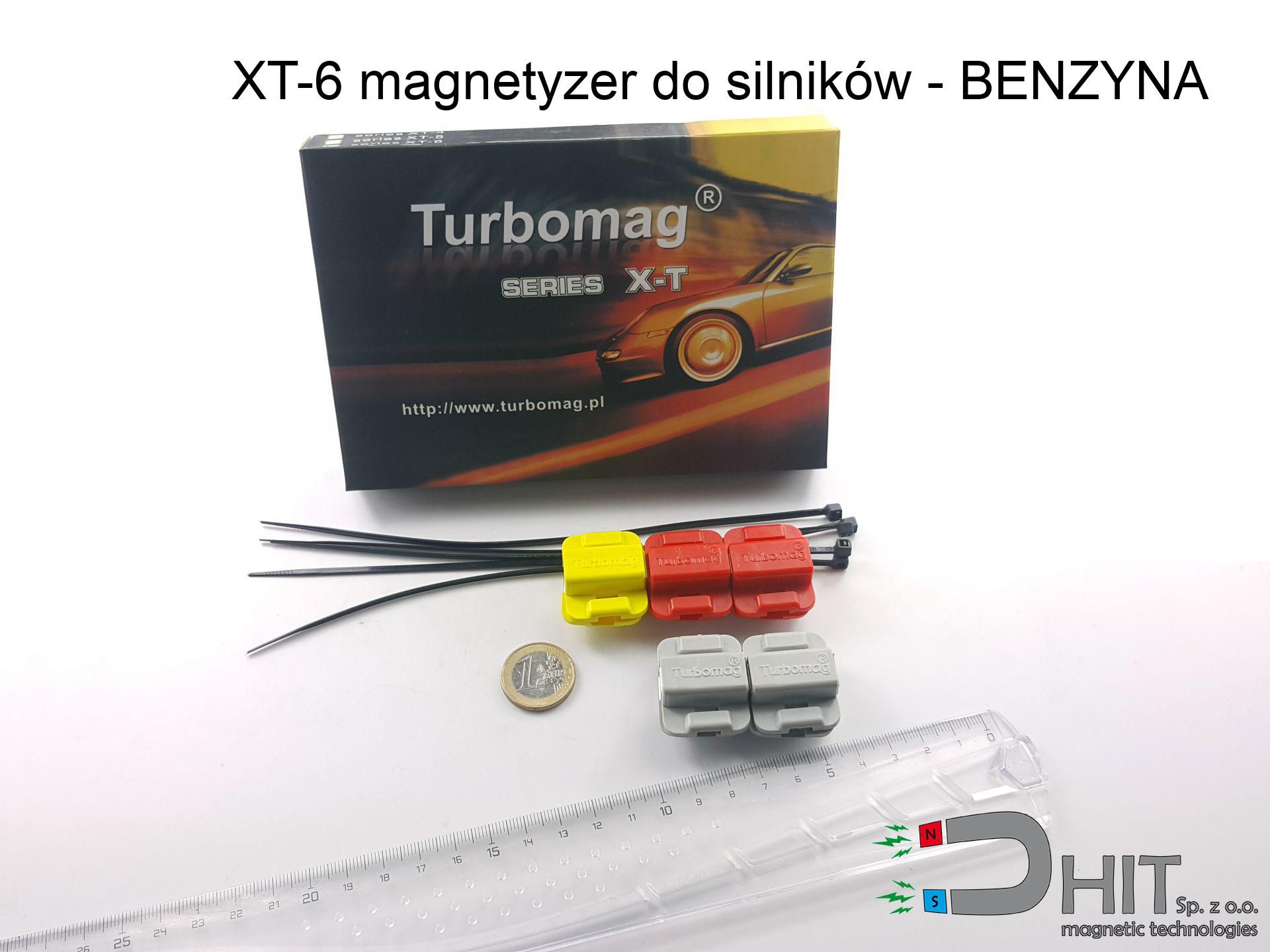MW 45x35 / N38 - cylindrical magnet
cylindrical magnet
Catalog no 010074
GTIN: 5906301810735
Diameter Ø
45 mm [±0,1 mm]
Height
35 mm [±0,1 mm]
Weight
417.49 g
Magnetization Direction
↑ axial
Load capacity
95.26 kg / 934.48 N
Magnetic Induction
521.39 mT
Coating
[NiCuNi] Nickel
180.10 ZŁ with VAT / pcs + price for transport
146.42 ZŁ net + 23% VAT / pcs
bulk discounts:
Need more?Do you have problems deciding?
Contact us by phone
+48 22 499 98 98
otherwise send us a note by means of
form
the contact page.
Lifting power and shape of a neodymium magnet can be calculated using our
magnetic calculator.
Orders submitted before 14:00 will be dispatched today!
MW 45x35 / N38 - cylindrical magnet
Specification / characteristics MW 45x35 / N38 - cylindrical magnet
| properties | values |
|---|---|
| Cat. no. | 010074 |
| GTIN | 5906301810735 |
| Production/Distribution | Dhit sp. z o.o. |
| Country of origin | Poland / China / Germany |
| Customs code | 85059029 |
| Diameter Ø | 45 mm [±0,1 mm] |
| Height | 35 mm [±0,1 mm] |
| Weight | 417.49 g |
| Magnetization Direction | ↑ axial |
| Load capacity ~ ? | 95.26 kg / 934.48 N |
| Magnetic Induction ~ ? | 521.39 mT |
| Coating | [NiCuNi] Nickel |
| Manufacturing Tolerance | ±0.1 mm |
Magnetic properties of material N38
| properties | values | units |
|---|---|---|
| remenance Br [Min. - Max.] ? | 12.2-12.6 | kGs |
| remenance Br [Min. - Max.] ? | 1220-1260 | T |
| coercivity bHc ? | 10.8-11.5 | kOe |
| coercivity bHc ? | 860-915 | kA/m |
| actual internal force iHc | ≥ 12 | kOe |
| actual internal force iHc | ≥ 955 | kA/m |
| energy density [Min. - Max.] ? | 36-38 | BH max MGOe |
| energy density [Min. - Max.] ? | 287-303 | BH max KJ/m |
| max. temperature ? | ≤ 80 | °C |
Physical properties of sintered neodymium magnets Nd2Fe14B at 20°C
| properties | values | units |
|---|---|---|
| Vickers hardness | ≥550 | Hv |
| Density | ≥7.4 | g/cm3 |
| Curie Temperature TC | 312 - 380 | °C |
| Curie Temperature TF | 593 - 716 | °F |
| Specific resistance | 150 | μΩ⋅Cm |
| Bending strength | 250 | Mpa |
| Compressive strength | 1000~1100 | Mpa |
| Thermal expansion parallel (∥) to orientation (M) | (3-4) x 106 | °C-1 |
| Thermal expansion perpendicular (⊥) to orientation (M) | -(1-3) x 10-6 | °C-1 |
| Young's modulus | 1.7 x 104 | kg/mm² |
Engineering modeling of the assembly - report
These values represent the outcome of a physical simulation. Results were calculated on algorithms for the class NdFeB. Real-world parameters might slightly deviate from the simulation results. Please consider these data as a reference point when designing systems.
MW 45x35 / N38
| Distance (mm) | Induction (Gauss) / mT | Pull Force (kg) | Risk Status |
|---|---|---|---|
| 0 mm |
5213 Gs
521.3 mT
|
95.26 kg / 95260.0 g
934.5 N
|
critical level |
| 1 mm |
4982 Gs
498.2 mT
|
87.02 kg / 87015.8 g
853.6 N
|
critical level |
| 2 mm |
4748 Gs
474.8 mT
|
79.04 kg / 79039.5 g
775.4 N
|
critical level |
| 5 mm |
4059 Gs
405.9 mT
|
57.75 kg / 57747.4 g
566.5 N
|
critical level |
| 10 mm |
3027 Gs
302.7 mT
|
32.13 kg / 32127.3 g
315.2 N
|
critical level |
| 15 mm |
2215 Gs
221.5 mT
|
17.19 kg / 17194.7 g
168.7 N
|
critical level |
| 20 mm |
1619 Gs
161.9 mT
|
9.19 kg / 9192.0 g
90.2 N
|
warning |
| 30 mm |
899 Gs
89.9 mT
|
2.83 kg / 2832.5 g
27.8 N
|
warning |
| 50 mm |
340 Gs
34.0 mT
|
0.40 kg / 404.4 g
4.0 N
|
safe |
MW 45x35 / N38
| Surface type | Friction coefficient / % Mocy | Max load (kg) |
|---|---|---|
| Raw steel |
µ = 0.3
30% Nominalnej Siły
|
28.58 kg / 28578.0 g
280.4 N
|
| Painted steel (standard) |
µ = 0.2
20% Nominalnej Siły
|
19.05 kg / 19052.0 g
186.9 N
|
| Oily/slippery steel |
µ = 0.1
10% Nominalnej Siły
|
9.53 kg / 9526.0 g
93.5 N
|
| Magnet with anti-slip rubber |
µ = 0.5
50% Nominalnej Siły
|
47.63 kg / 47630.0 g
467.3 N
|
MW 45x35 / N38
| Steel thickness (mm) | % power | Real pull force (kg) |
|---|---|---|
| 0.5 mm |
|
3.18 kg / 3175.3 g
31.2 N
|
| 1 mm |
|
7.94 kg / 7938.3 g
77.9 N
|
| 2 mm |
|
15.88 kg / 15876.7 g
155.8 N
|
| 5 mm |
|
39.69 kg / 39691.7 g
389.4 N
|
| 10 mm |
|
79.38 kg / 79383.3 g
778.8 N
|
MW 45x35 / N38
| Ambient temp. (°C) | Power loss | Remaining pull | Status |
|---|---|---|---|
| 20 °C | 0.0% |
95.26 kg / 95260.0 g
934.5 N
|
OK |
| 40 °C | -2.2% |
93.16 kg / 93164.3 g
913.9 N
|
OK |
| 60 °C | -4.4% |
91.07 kg / 91068.6 g
893.4 N
|
OK |
| 80 °C | -6.6% |
88.97 kg / 88972.8 g
872.8 N
|
|
| 100 °C | -28.8% |
67.83 kg / 67825.1 g
665.4 N
|
MW 45x35 / N38
| Gap (mm) | Attraction (kg) (N-S) | Repulsion (kg) (N-N) |
|---|---|---|
| 0 mm |
142.89 kg / 142890.0 g
1401.8 N
|
N/A |
| 2 mm |
118.56 kg / 118560.0 g
1163.1 N
|
110.66 kg / 110656.0 g
1085.5 N
|
| 5 mm |
86.63 kg / 86625.0 g
849.8 N
|
80.85 kg / 80850.0 g
793.1 N
|
| 10 mm |
48.20 kg / 48195.0 g
472.8 N
|
44.98 kg / 44982.0 g
441.3 N
|
| 20 mm |
13.79 kg / 13785.0 g
135.2 N
|
12.87 kg / 12866.0 g
126.2 N
|
| 50 mm |
0.60 kg / 600.0 g
5.9 N
|
0.56 kg / 560.0 g
5.5 N
|
MW 45x35 / N38
| Object / Device | Limit (Gauss) / mT | Safe distance |
|---|---|---|
| Pacemaker | 5 Gs (0.5 mT) | 26.5 cm |
| Hearing aid | 10 Gs (1.0 mT) | 20.5 cm |
| Mechanical watch | 20 Gs (2.0 mT) | 16.0 cm |
| Mobile device | 40 Gs (4.0 mT) | 12.5 cm |
| Car key | 50 Gs (5.0 mT) | 11.5 cm |
| Payment card | 400 Gs (40.0 mT) | 5.0 cm |
| HDD hard drive | 600 Gs (60.0 mT) | 4.0 cm |
MW 45x35 / N38
| Start from (mm) | Speed (km/h) | Energy (J) | Predicted outcome |
|---|---|---|---|
| 10 mm |
18.16 km/h
(5.05 m/s)
|
5.31 J | |
| 30 mm |
26.87 km/h
(7.46 m/s)
|
11.63 J | |
| 50 mm |
34.15 km/h
(9.49 m/s)
|
18.79 J | |
| 100 mm |
48.18 km/h
(13.38 m/s)
|
37.39 J |
MW 45x35 / N38
| Technical parameter | Value / Description |
|---|---|
| Coating type | [NiCuNi] Nickel |
| Layer structure | Nickel - Copper - Nickel |
| Layer thickness | 10-20 µm |
| Salt spray test (SST) ? | 24 h |
| Recommended environment | Indoors only (dry) |
MW 45x35 / N38
| Environment | Effective steel pull | Effect |
|---|---|---|
| Air (land) | 95.26 kg | Standard |
| Water (riverbed) |
109.07 kg
(+13.81 kg Buoyancy gain)
|
+14.5% |
Other deals
Pros as well as cons of rare earth magnets.
Apart from their consistent magnetism, neodymium magnets have these key benefits:
- They have constant strength, and over nearly ten years their attraction force decreases symbolically – ~1% (according to theory),
- They feature excellent resistance to magnetism drop when exposed to opposing magnetic fields,
- The use of an metallic layer of noble metals (nickel, gold, silver) causes the element to be more visually attractive,
- They are known for high magnetic induction at the operating surface, which improves attraction properties,
- Thanks to resistance to high temperature, they are capable of working (depending on the form) even at temperatures up to 230°C and higher...
- Thanks to versatility in designing and the ability to adapt to unusual requirements,
- Fundamental importance in future technologies – they are used in data components, brushless drives, diagnostic systems, also modern systems.
- Thanks to efficiency per cm³, small magnets offer high operating force, with minimal size,
Cons of neodymium magnets: application proposals
- To avoid cracks under impact, we recommend using special steel housings. Such a solution protects the magnet and simultaneously improves its durability.
- We warn that neodymium magnets can reduce their strength at high temperatures. To prevent this, we suggest our specialized [AH] magnets, which work effectively even at 230°C.
- Magnets exposed to a humid environment can corrode. Therefore during using outdoors, we advise using water-impermeable magnets made of rubber, plastic or other material resistant to moisture
- Due to limitations in realizing threads and complex shapes in magnets, we propose using casing - magnetic holder.
- Health risk to health – tiny shards of magnets can be dangerous, if swallowed, which becomes key in the aspect of protecting the youngest. Furthermore, tiny parts of these devices are able to be problematic in diagnostics medical when they are in the body.
- With budget limitations the cost of neodymium magnets is economically unviable,
Magnetic strength at its maximum – what affects it?
Breakaway force was determined for optimal configuration, assuming:
- on a base made of mild steel, effectively closing the magnetic field
- whose thickness equals approx. 10 mm
- with an ground contact surface
- with direct contact (no coatings)
- under axial application of breakaway force (90-degree angle)
- at room temperature
Magnet lifting force in use – key factors
In real-world applications, the actual lifting capacity depends on several key aspects, listed from the most important:
- Distance – the presence of any layer (rust, tape, gap) acts as an insulator, which lowers capacity rapidly (even by 50% at 0.5 mm).
- Angle of force application – highest force is reached only during pulling at a 90° angle. The force required to slide of the magnet along the surface is usually many times smaller (approx. 1/5 of the lifting capacity).
- Substrate thickness – to utilize 100% power, the steel must be adequately massive. Paper-thin metal limits the lifting capacity (the magnet "punches through" it).
- Chemical composition of the base – mild steel gives the best results. Alloy admixtures decrease magnetic permeability and holding force.
- Surface finish – full contact is possible only on smooth steel. Any scratches and bumps create air cushions, reducing force.
- Temperature influence – high temperature weakens magnetic field. Exceeding the limit temperature can permanently damage the magnet.
* Lifting capacity testing was carried out on plates with a smooth surface of optimal thickness, under a perpendicular pulling force, however under shearing force the lifting capacity is smaller. In addition, even a slight gap {between} the magnet’s surface and the plate reduces the holding force.
H&S for magnets
Electronic devices
Powerful magnetic fields can corrupt files on credit cards, hard drives, and storage devices. Stay away of at least 10 cm.
Medical interference
Patients with a heart stimulator should maintain an absolute distance from magnets. The magnetism can disrupt the functioning of the implant.
Allergy Warning
Studies show that nickel (standard magnet coating) is a common allergen. If your skin reacts to metals, refrain from direct skin contact or choose versions in plastic housing.
Handling rules
Handle with care. Neodymium magnets attract from a long distance and connect with huge force, often faster than you can move away.
Compass and GPS
Note: neodymium magnets produce a field that interferes with precision electronics. Maintain a separation from your mobile, tablet, and navigation systems.
Fire warning
Powder generated during machining of magnets is self-igniting. Avoid drilling into magnets without proper cooling and knowledge.
Swallowing risk
Only for adults. Small elements pose a choking risk, leading to serious injuries. Keep away from kids and pets.
Crushing risk
Danger of trauma: The attraction force is so immense that it can result in hematomas, pinching, and broken bones. Protective gloves are recommended.
Thermal limits
Watch the temperature. Heating the magnet above 80 degrees Celsius will permanently weaken its magnetic structure and strength.
Beware of splinters
Despite the nickel coating, the material is delicate and not impact-resistant. Do not hit, as the magnet may crumble into hazardous fragments.
Security!
Looking for details? Read our article: Why are neodymium magnets dangerous?




![SM 32x275 [2xM8] / N42 - magnetic separator SM 32x275 [2xM8] / N42 - magnetic separator](https://cdn3.dhit.pl/graphics/products/sm-32x275-2xm8-hac.jpg)
![BM 450x180x70 [4x M8] - magnetic beam BM 450x180x70 [4x M8] - magnetic beam](https://cdn3.dhit.pl/graphics/products/bm-450x180x70-4x-m8-duh.jpg)



